So. Why did I go to South Africa? There are lots of good reasons. Too many to list, but suffice it to say that I could have made a well considered and educated decision to go to South Africa and spend most of my time there in Kruger National Park. The actual process was somewhat more haphazard. I went because my brother noticed a two for one deal on air fare to Johannesburg, and could trade his condo for a week in one in Hazyview.
Starting from there, it did not take me long to figure out that we would not be making a thorough tour of the country - it is really big, and I am not one to spend my whole vacation in a car, or worse, in airports. (Though as it turned out, I spent large amounts of this vacation in my car, and was quite happy about it). It was also not hard to figure out that if you are staying in Hazyview, you are going to spend a fair amount of time in Kruger National Park. A green space on the map the size of New Jersey is hard to miss. And while there are a few other things in the area, there are not a lot.
How to deal with Kruger was another matter. Many sources talked like the only way to see anything in the park was to stay there. Lonely Planet listed that possibly, and activities like five day drives, and equally long walks with guides with guns. There were also plenty of places that will drive you around the park and show you things. This sounded like a grand idea for a day or so, but not for days on end. It isn't cheap, and I have a tendency of getting tired of having my life in someone else's control. So I was stumped. But one day while wandering around on the web looking for a map of the park, I found a site on drives through the park. Not drives you pay for, but hopping in your own car and driving around to see the sights.
I admit that I was skeptical. Driving around for entertainment is really not like me. I want to get out in a place and walk around it. More importantly, I was pretty certain that any sane animals would be as far away from roads full of cars as they could get. This was where I was wrong. Sane animals walk around on the road, run down it to get a clear view, and even sleep on it to get warm.
On the first day, we drove in Paul Kruger Gate, and within a kilometer we had seen a leopard sleeping in a tree and a few hundred impala (the Big Mac of the Kruger). We drove up past Tshokwane picnic area to the baobab tree, and by the end of the day we had seen, among other things, giraffes, zebras, water buffalo, baboons and a whole herd of elephants sleeping right next to the road.
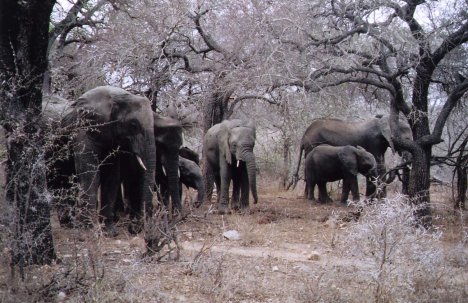 I was hooked.
I was hooked.
The only one of the "big five" we did not see the first day were rhinos, so that night I looked up a route that had the reputation of having a lot of rhinos. We took the Voortrekker road down to Afsaal picnic area and from there to Berg En Dal camp for lunch, and back to Pretoriuskop. It indeed had rhinos, including one that wandered within about fifteen feet of the car before we lost our nerve and left. 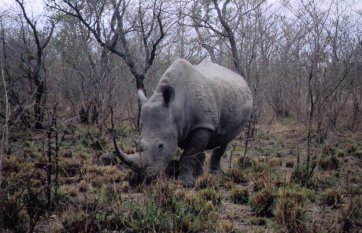 It also had humor. Following a dirt road on the direction of a sign that said it lead to a "historic area," we found a sign that said:
It also had humor. Following a dirt road on the direction of a sign that said it lead to a "historic area," we found a sign that said:
This is the place where Sir Percy Fitzpatrick's famous dog, Jock of the Bushveld, was born early in 1885. The grave nearby is that of a young German, Adolf Soitke (aged 23 years) who accompanied a group of transport riders in the 1880's. He accidentally shot himself in the leg with a double-barreled shotgun, dying subsequently of the wound, despite all efforts to save his life.
We about died laughing.
By the end of the second day we were in agreement that when we left the resort in Hazyview, we should move into the park for a few days. We did this partly because it was my ambition to go on a morning walk, which is about the only practical way to hike in the park. (I had by then seen enough things that could kill me walking around on the road to figure out why you aren't supposed to get out of the car). And partly because we were both so fascinated with the park that we knew we wanted to spend more time there.
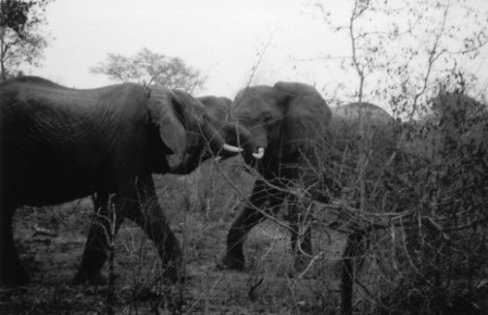
In the meantime, however, I needed to use my feet and legs a bit, so on the third day, for a change of pace, we did a tour of local water falls and scenery and Pilgrims Rest, an historic gold mining town.
The next day, we went back to the park, but with a guide. This had the advantage of giving my brother a day off driving, and also allowed us to talk to someone who knew a lot more than either of us about the things that we were seeing. Not to mention that his eyes were better than ours, allowing us to see things that we may not otherwise have noticed, like wild dogs (apparently a rare find). Then we went back to driving ourselves around the park for entertainment - for the remaining two days we were at the resort, and three days we stayed in the park. We did not get bored with it. In fact, I would recommend it to anyone. The sole qualifications are vision, and the ability to go a few hours at a time without going to a bathroom. Other than that, anyone can play.
In the park we stayed the first night in a hut in Satara and the next two nights in a hut in Oliphants. Both camps were nice, but I loved Oliphants for the view, which we could see from our kitchen - conveniently located, as it was, on the back porch. 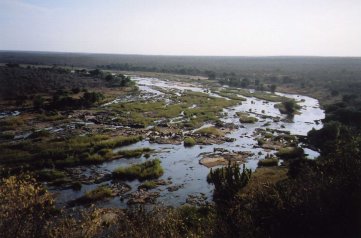 We took a sunset drive from Satara. (Do it yourself sunset drives are impossible because all the gates - to the outside and to the camps - close at sunset). We saw a number of things, but the exciting part was the lions who had decided to sleep in the road, and were only mildly annoyed when the bus stopped right next to them so we could gawk and take photos. We also took a morning walk from Oliphants. (Do it yourself morning walks are impossible because they are illegal and dangerous, and are possible when operated by the park only because two men with big guns go with you).
We took a sunset drive from Satara. (Do it yourself sunset drives are impossible because all the gates - to the outside and to the camps - close at sunset). We saw a number of things, but the exciting part was the lions who had decided to sleep in the road, and were only mildly annoyed when the bus stopped right next to them so we could gawk and take photos. We also took a morning walk from Oliphants. (Do it yourself morning walks are impossible because they are illegal and dangerous, and are possible when operated by the park only because two men with big guns go with you). We saw all sorts of things on that walk as well, including some remaining bones from a hippo they had to shoot on a morning walk earlier in the week.
We did do other things as well. For one thing, we ate. South African cuisine is a mixed bag - with elements of African, Dutch, Malaysian, Indian, British and other cuisines, though fortunately, at least at the Johannesburg end, not too much British. The Braai is very popular and both the resort and the huts at the park were supplied with them. A braai is essentially a barbecue, but the fare tends more toward large cuts of meat, long strings of sausages and so on, rather than hot dogs and burgers. Spinach and squash were also very popular, which was fine with me. The primary format, both at the resort, and at restaurants in the park, was the carvery. This involved a couple types of meat at a carving table, a salad bar, and a buffet of vegetables, starches, and a casserole. The resort also had a mongolian barbecue night and a curry night, and I ordered a la carte one night to try the wart hog, which was good. The park was pretty much carvery or a la carte every night, and I had carvery for the first two nights, until it finally occurred to be that the term "selection" in the phrase "ask about our venison selection" referred to the type of animal, not the way it was prepared. That night the selection was kudu steak, and it was very good.
The resort also had hippos, crocodiles, and an incredible number of birds, complete with a hide to watch them from. The agreement that had been worked out with the hippos required the resort to open the gates out to the forest after sundown each night and leave them open until just before sunrise. The hippos would collect in the part of the moat closest to the gate around sundown, leave at their own incredibly slow pace when the gates opened, and wander back in whenever they finished foraging for the night. We went out one night to watch them leave, and it was rather entertaining, if slow moving.
Eventually, we left the park, and went to Pretoria, or Tshwane, depending on who you ask. There we did the typical tourist things - Church Square (the center of town), museums, parks and monuments. Many of these were interesting, some more than others. I was amused to see that the Museum of Natural History had an elephant in the middle of the main hall, just like the one in DC.
The museums and monuments, together with the Shangana Cultural Center in Hazyview did permit me to learn much that I had not known about South African history, but not nearly as much as I would have liked to. There are more cultures there than it is reasonably possible to present, and perhaps, a lack of recorded history from which to present it. Moreover, what has been recorded was often not recorded by people from the culture most affected, with the result that the viewpoint of the presenter always had to be kept in mind. Nevertheless, despite my efforts, I know much more about the history and culture of white South Africans, and much less about those of the other peoples of South Africa, except of course, to the extent that those other peoples were affected by the actions of white South Africans.
The truth is, I spent far too little time in any part of South Africa outside the park to be able to say much about anyone's culture. Certainly, from the point of view of the architecture, infrastructure, shopping, restaurants, and even the driving and traffic enforcement, much of South Africa that I saw seemed to be very European. Many parts could have appeared in Europe, at least if it were not for the fortresses around the houses of the well-to-do. I have no idea if these fortresses are even vaguely necessary, but I can tell you that they can convert what ought to be one of the safest streets in town into a very creepy place to walk in the evening.
I can also tell you that I have never seen so many disclaimers of liability in my life. 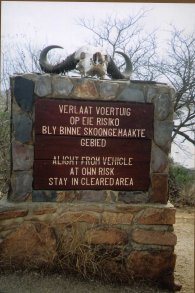 There is practically nothing that one can do in South Africa where some sign will not announce to you that you are doing it at your own risk. I have no idea why this is, however, as I was assured that it was not a particularly litigious country.
There is practically nothing that one can do in South Africa where some sign will not announce to you that you are doing it at your own risk. I have no idea why this is, however, as I was assured that it was not a particularly litigious country.
And finally, I can tell you that, South Africa rivals Ireland for the incomprehensibility of its spoken English. The reasons are different, however. South Africa has 11 official languages, and more that are not official. Everyone we met spoke English, but only about 8% of the country speaks it as their first language. As a result, there is not simply one basic accent (not that South African has not also picked up its own characteristics as time goes on) but accents arising from the various first languages of the speakers, each of which is unique.
CONCLUSION